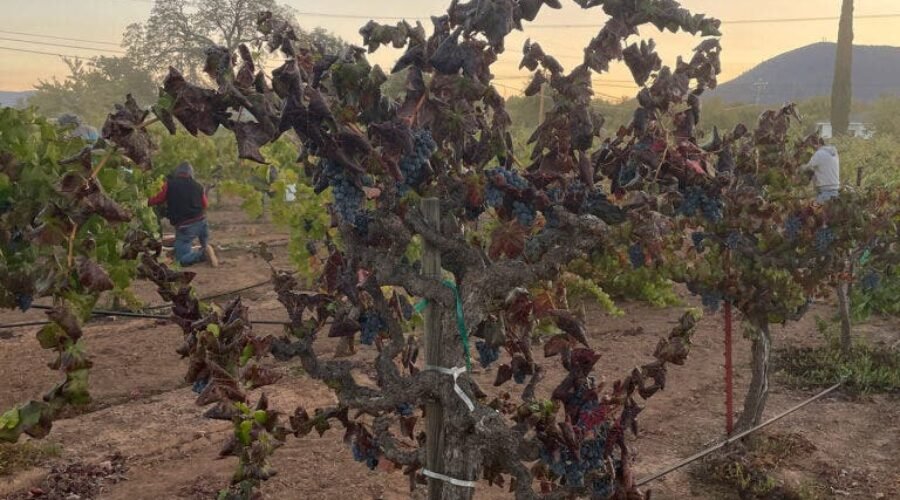The Magic (and Madness) of Head-Trained Vines
In a few pockets of the Napa Valley—and up in Lodi, along with arid parts of Spain—you can see them: old and gnarled vines, planted 60, 70, 80 years ago and standing strong and sturdy, like elder statesmen.
They bloom and curl out of the ground without the constraints of wires or stakes. They’re free-standing, bush-like vines that, as winemakers will tell you, are incredibly arduous to work with.
But head-trained vines are magic to those who subscribe to their spells. “It’s not the best choice economically, but it just makes better wine,” says Steven Rasmussen, proprietor of Palisades Canyon in Napa.
Head-trained vines, known as goblet or bush vines, are grape vines that are pruned and grown so the arms shoot outwards in curves, like a wine glass. They look almost like bushes, with thick trunks and low profiles.
Deep vines are a labor of love—or, as some winemakers may put it, a pain in the ass. They’re time-intensive, expensive and fickle at best. The goblet vines that remain are kept by dedicated vintners who believe that the method produces superior wines.
“I love working with head-trained vines, even though they’re the hardest thing to work with,” says Scott Kirkpatrick, director of winemaking at Dancing Crow Vineyards in Hopland, California. “Unpredictable—you have the least amount of control possible. I can’t sample the vineyard, so there’s no way to get a sense of the sugar.”
So he lets his Zinfandel get riper than he’d like before harvesting to make up for the slower varieties in the vineyard. “That’s the trick with our old vines—none of it would be great on its own. When it comes together, it becomes really special.”
The Rise and Fall of Head-Trained Vines
While once found across California, head-trained vines have fallen out of favor. Many winemakers consider them too expensive to maintain, with too little yield to make them feasible.
In 1871, Scottish settler James Horn landed in Calistoga’s Palisades Canyon and planted four acres of bush vines. Italian immigrant Domenico Barberis took over 20 years later; then, Prohibition hit.
On the books, he made sacramental wine. Off-record, he contributed to Calistoga’s underground booze industry. The IRS eventually caught up to him, and his winery was forced to shut down, though they kept tending to the vines and selling the grapes elsewhere. Over the years, the head-trained vines got almost entirely replaced by lithe, wire-guided vines, save for a few head-trained Petite Sirah vines.
Then, winemakers Felicia Woytak and Steven Rasmussen moved in. They removed the trellises. They planted Chenin Blanc, Petite Sirah, Cabernet Sauvignon and Cabernet Franc and coaxed them back into goblet vines.
Once upon a time, virtually all of Napa Valley’s vineyards looked like theirs. Now, they’re one of a few head-trained vineyards left in the valley.
Dancing Crow’s Old Stake Vineyards, located high above California’s volcanic Lake County region, was planted with head-trained vines long before Prohibition. There are 24 different varieties dotting the vineyard, including Alicante Bouschet, a touch of Cabernet Sauvignon and a big hit of Zinfandel. All are harvested and fermented together.
Head-training is an unusual approach, but think about the context, says Kirkpatrick.
“In 1901, Italian immigrants were coming into an area they’ve never been before,” he says. “There’s no nursery down the street where you can buy 10,000 Cabernet vines. You’re grabbing whatever cuttings you can. You don’t know what pests are in the area.You don’t know the frost situation, or the mildew pressure. You plant as many things as possible so if there’s a big issue with one, it’s not going to cripple you.”
// Create the element
var script_6859a9115db3a = document.createElement(“script”);
script_6859a9115db3a.innerHTML = `
window.googletag = window.googletag || {cmd: []};
googletag.cmd.push(function() {
var adType = “leaderboard”;
var mapping;
var lbmapping = googletag.sizeMapping()
.addSize([1024, 0], [[970, 250], [970, 90], [1, 1], [728, 90]])
.addSize([728, 0], [[728, 90], [1, 1]])
.addSize([320, 0], [[1, 1], [300, 50], [300, 100], [320, 50], [320, 100]])
.addSize([0, 0], [[1, 1], [320, 50]])
.build();; // Size mapping for leaderboard ads
var medrecmapping = googletag.sizeMapping()
.addSize([1024, 0], [[300, 600],[300, 250]])
.addSize([728, 0], [300, 250])
.addSize([320, 0], [[1, 1],[300, 250]])
.addSize([0, 0], [[1, 1], [300, 250]])
.build(); // Size mapping for med rectengle ads
if(‘/39808611/article_page/article_leaderboard_1’ == ‘/39808611/article_page/article_leaderboard_1’
|| ‘/39808611/article_page/article_leaderboard_1’ == ‘/39808611/article_page/article_leaderboard_2’
|| ‘/39808611/article_page/article_leaderboard_1’ == ‘/39808611/article_page/article_leaderboard_3’) {
mapping = googletag.sizeMapping()
.addSize([1920, 0], [[728, 90]]) // >= 1920px
.addSize([1440, 0], [[728, 90]]) // 1440px-1919px
.addSize([730, 0], [[300, 250]]) // 730px-1439px
.addSize([0, 0], [[320, 100], [320, 50], [300, 100], [300, 50], [300, 250]]) // Up to 729px
.build();
} else {
mapping = adType == ‘leaderboard’ ? lbmapping : medrecmapping;
}
googletag.defineSlot(‘/39808611/article_page/article_leaderboard_1’, [],
‘div-gpt-ad-6859a9115db3a’).addService(googletag.pubads()).defineSizeMapping(mapping);
googletag.pubads().enableSingleRequest();
googletag.pubads().collapseEmptyDivs();
googletag.display(‘div-gpt-ad-6859a9115db3a’);
});
`;
// Append the script to the body
document.body.appendChild(script_6859a9115db3a);
He adds, “It was also very Italian to plant white varieties in with the red—it was good luck, but also built acidity in the wines.”
120 years later, these historical head-trained vines are still thriving.
They act as a classroom for Simonit and Sirch, master pruners for clients like Chateau Latour, Corison, Domaine Leflaive and Chateau d’Yquem, who are teaching the next generation the benefits of tight pruning and head-trained vines.
“There’s no hard data that you can rely on yet,” says Kirkpatrick, “but they’re seeing better tannins, better phenolics and much better grape chemistries.”

Head-Trained Vines Around the World
In some regions around the world, head-training is more common for both historical and practical reasons.
In Puglia, head-trained Primitivo is a deep-rooted part of local viticulture, in part due to the climate. “One of the main benefits of head-trained vines is their deep root system, which allows them to thrive in our hot, dry climates, making them especially well-suited to the conditions in Puglia,” says Marzia Varvaglione, of Varvaglione 1921. “This resilience to drought is a big reason why we continue to use this training system.”
They’re also common in the South of France, as head-trained vines are ideal for dry farming in warmer areas—their root system can go deep and pull out water—and are resilient in the face of changing climates. Same with Spain: the deep root system allows the Monastrell and Garnacha to survive without irrigation.
On Pico Island in the Azores, head-training is the only option. Vines are planted in cracks in the volcanic plains and trained as low bushes, so they can brace against the strong Atlantic winds. Vineyard workers build small stone fences around each plant to protect the trunks from the elements.
Old, head-trained vines are veterans—weathered and wise after years and years of growth. They produce wines with character, depth, nuance and knowledge.
“Head-trained vines are among our oldest vineyards, which means greater complexity and stability,” says Varvaglione. “These vines better withstand water stress, and Primitivo thrives under these conditions, allowing it to fully express its unique characteristics. This results in wines with more concentrated fruit, softer tannins and full ripening of the seeds, which gives the wine naturally toasted notes.”

The Hurdles of Head Training
While the wine is intangibly beautiful, head-training is not for the faint of heart, or wallet. They’re laborious to maintain and expensive to upkeep.
“Up front, head-trained vines are more affordable—you don’t have to buy as many stakes, wires, and such,” says Kirkpatrick. “But it’s more expensive every step of the way. You can’t go through and hedge the vineyard with a tractor. It’s more expensive to maintain, prune and pick.”
The upkeep requires an enormous amount of human labor. Varvaglione’s wines weren’t planted in neat rows, which makes it impossible to use machinery in the vines. “All the work must be done by hand, from pruning to soil management and harvest,” she says. “It slows things down and reduces our ability to respond quickly, especially in bad weather.”
Head-trained vines also require careful attention. “There are skill issues when it comes to pruning and picking,” says Kirkpatrick. “It’s the best crews who come in and do that, which will always cost you more. And labor is getting harder and harder to find.”
As you prune, you’re slowly shaping the plant’s form—every cut matters. So Rasmussen looks for continuity, seeking out the same vineyard team year after year. “It’s chess versus checkers,” Rasmussen says. “Checkers, you’re thinking a move or two ahead. Chess, you’re thinking five to ten.”

The Enduring Allure of Old Vines
Longevity is a big upside of head-trained vines. Kirkpatrick’s vines are well over a century old. In Lodi, head-trained Zinfandel planted in the 1800s is still producing fruit.
Rasmussen’s vines, the oldest of which are 60-ish years old, are planted eight feet apart from each other, which allows the roots to go deep and reap the benefits of more nutrients, minerals and flavors.
“There’s four times the amount of dirt per vine,” he says. “If you plant a typical vineyard, the vines simply wouldn’t be productive 60 years down the road because the soil would be depleted.”
Grape growers have noticed that old head-trained vines are more resilient and less susceptible to heat, drought and other climate maladies. “With the openness of the canopy, we don’t have the pressures of powdery mildew that you would have in trellised vineyards—we have to spray less often,” says Rasmussen.
// Create the element
var script_6859a9115eb80 = document.createElement(“script”);
script_6859a9115eb80.innerHTML = `
window.googletag = window.googletag || {cmd: []};
googletag.cmd.push(function() {
var adType = “leaderboard”;
var mapping;
var lbmapping = googletag.sizeMapping()
.addSize([1024, 0], [[970, 250], [970, 90], [1, 1], [728, 90]])
.addSize([728, 0], [[728, 90], [1, 1]])
.addSize([320, 0], [[1, 1], [300, 50], [300, 100], [320, 50], [320, 100]])
.addSize([0, 0], [[1, 1], [320, 50]])
.build();; // Size mapping for leaderboard ads
var medrecmapping = googletag.sizeMapping()
.addSize([1024, 0], [[300, 600],[300, 250]])
.addSize([728, 0], [300, 250])
.addSize([320, 0], [[1, 1],[300, 250]])
.addSize([0, 0], [[1, 1], [300, 250]])
.build(); // Size mapping for med rectengle ads
if(‘/39808611/article_page/article_leaderboard_2’ == ‘/39808611/article_page/article_leaderboard_1’
|| ‘/39808611/article_page/article_leaderboard_2’ == ‘/39808611/article_page/article_leaderboard_2’
|| ‘/39808611/article_page/article_leaderboard_2’ == ‘/39808611/article_page/article_leaderboard_3’) {
mapping = googletag.sizeMapping()
.addSize([1920, 0], [[728, 90]]) // >= 1920px
.addSize([1440, 0], [[728, 90]]) // 1440px-1919px
.addSize([730, 0], [[300, 250]]) // 730px-1439px
.addSize([0, 0], [[320, 100], [320, 50], [300, 100], [300, 50], [300, 250]]) // Up to 729px
.build();
} else {
mapping = adType == ‘leaderboard’ ? lbmapping : medrecmapping;
}
googletag.defineSlot(‘/39808611/article_page/article_leaderboard_2’, [],
‘div-gpt-ad-6859a9115eb80’).addService(googletag.pubads()).defineSizeMapping(mapping);
googletag.pubads().enableSingleRequest();
googletag.pubads().collapseEmptyDivs();
googletag.display(‘div-gpt-ad-6859a9115eb80’);
});
`;
// Append the script to the body
document.body.appendChild(script_6859a9115eb80);
Kirkpatrick appreciates their strong natural canopy, which helps protect against sun intensity while still allowing good airflow through the vines.
That said, these vines are an expensive salve to the ravages of climate change. “We’re in a weird, difficult moment in the industry—it’s tough to suggest that the most expensive way of growing vines may be the best way forward,” says Kirkpatrick.
But there’s a beautiful responsibility to keeping head-trained vines alive and thriving.
“A big part of owning property is the stewardship of history,” he says. “I don’t want these vines to go away on my watch.”
There have been vintages when he could have pushed the vineyard to produce more. He didn’t.
“I want the vineyard to continue getting healthier instead of me asking and asking,” he says. “If you honor the vineyard’s desires, it will continue to reward you.”
More Winemaking Coverage:
- Read about how California winemakers are getting scrappy in the face of wildfires.
- In praise of dung beetles: The unsung, poop-eating heroes of the vineyard.
- Some winemakers are serenading their vines. Does it make for better wines?
- From classroom to cellar, women are leading the future of Cava.
- Why some winemakers are abandoning geographical indications.

From the Shop
Find Your Wine a Home
Our selection of red wine glasses is the best way to enjoy the wine’s subtle aromas and bright flavors.
The post The Magic (and Madness) of Head-Trained Vines appeared first on Wine Enthusiast.


